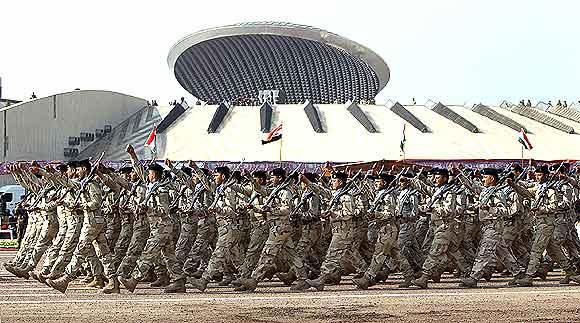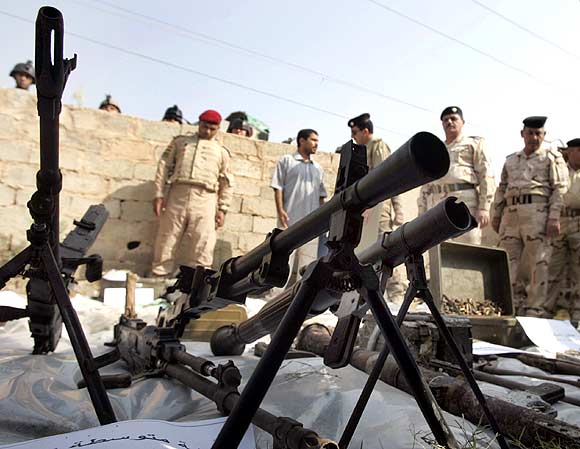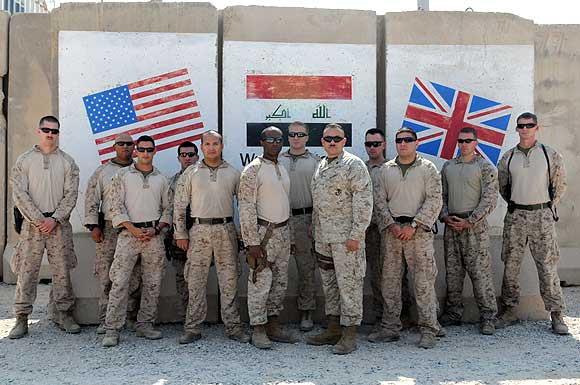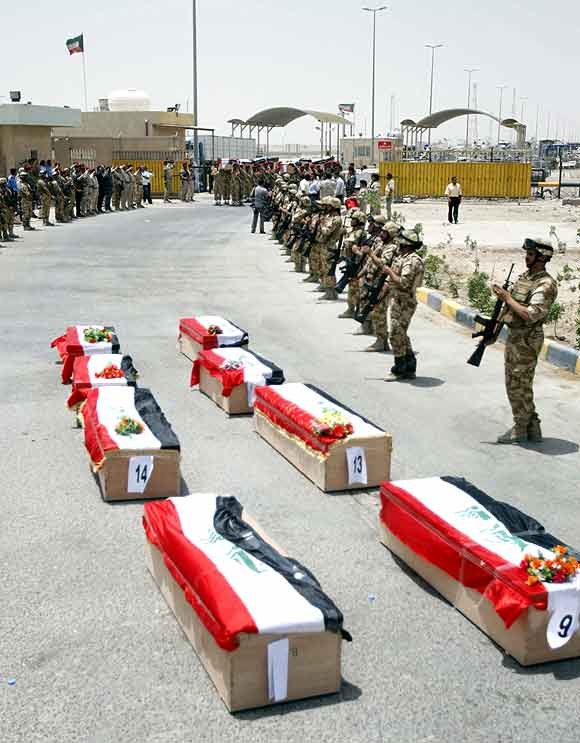Photographs: Saad Shalash/Reuters
The United States is set to bolster its military presence in the Persian Gulf by posting combat forces in Kuwait to respond to a collapse of security in Iraq or a military confrontation with Iran.
The build-up of troops in Kuwait will come after the remaining American troops withdraw from Iraq later this year, the New York Times reported, quoting officials and diplomats.
The repositioning of the US forces in the region, besides deploying combat troops in Kuwait, also envisages sending more naval warships to international waters off the region.
Negotiations for placing ground combat troops in Kuwait are going on. The new US military response would also entail expanded military ties with six nations of the
Gulf Cooperation Council -- Saudi Arabia, Qatar, Kuwait, Bahrain, Oman and UAE.
US military's plans AFTER troop withdrawal from Iraq
Image: Coloured smoke is seen as an Iraqi soldier fires at targets during a training course supervised by the US Army at a military base in NassiriyaPhotographs: Atef Hassan/Reuters
Though Washington already has close military ties with all the Gulf nations, officials said US was planning a "security architecture" for the region that would integrate air, naval patrols and missile defence, the report said.
President Barack Obama has already announced that all US troops would leave Iraq by the end of the year, ending the eight-year war, but American officials fear that the withdrawal could lead to instability or worse in its wake.
The US is pressing the Iraqi government to permit as many as 20,000 American troops to remain in Iraq beyond 2011, but the Pentagon is also drawing up an alternative security map.
The size of the standby American combat force to be based in Kuwait remains the subject of negotiations, with an answer expected in coming days.
US military's plans AFTER troop withdrawal from Iraq
Image: Confiscated weapons and explosive materials are displayed for the media after an army raid on a weapons cache in western BaghdadPhotographs: Mahmoud Raouf /Reuters
Officers at the Central Command headquarters declined to discuss specifics of the proposals, but it was clear that successful deployment plans from past decades could be incorporated into plans for a post-Iraq footprint in the region.
For example, in the time between the Persian Gulf war in 1991 and the invasion of Iraq in 2003, the US Army kept at least a combat battalion -- and sometimes a full combat brigade -- in Kuwait year-round, along with an enormous arsenal ready to be unpacked should even more troops have been called to the region.
"Back to the future" is how Major General Karl R Horst, Central Command's chief of staff, described planning for a new posture in the Gulf.
He said the command was focusing on smaller but highly capable deployments and training partnerships with regional militaries.
"We are kind of thinking of going back to the way it was before we had a big 'boots on the ground' presence. I think it is healthy. I think it is efficient. I think it is practical," Horst said.
US military's plans AFTER troop withdrawal from Iraq
Image: A team of 13 US Marine Corps trainers assigned to the Iraqi Marine Training Team gather for a photoPhotographs: Reuters
Obama and his senior national security advisers have sought to reassure allies and answer critics, including many Republicans, that the US will not abandon its commitments in the Persian Gulf even as it winds down the war in Iraq and looks ahead to doing the same in Afghanistan by the end of 2014.
"We will have a robust continuing presence throughout the region, which is proof of our ongoing commitment to Iraq and to the future of that region, which holds such promise and should be freed from outside interference to continue on a pathway to democracy," Secretary of State Hillary Clinton said in Tajikistan after the President's announcement.
During town-hall-style meetings with military personnel in Asia last week, Secretary of Defence Leon E Panetta noted that the US had 40,000 troops in the region, including 23,000 in Kuwait, though the bulk of those serve as logistical support for the forces in Iraq.
The New York Times, quoting officials of the US Central command, said that the post-Iraq era required them to seek more efficient ways to deploy forces and maximise cooperation with regional partners.
US military's plans AFTER troop withdrawal from Iraq
Image: Coffins bearing the remains of Iraqi soldiers who were killed during the 1991 Gulf WarPhotographs: Atef Hassan/Reuters
One significant outcome of the coming cuts, officials said, could be a steep decrease in the number of intelligence analysts assigned to the region. At the same time, officers hope to expand security relationships in the region.
The US move to reposition forces in the Gulf still requires the approval of the GCC, whose leaders will meet again in December in the Saudi capital, Riyadh, and the kind of multilateral collaboration that the administration envisions must overcome rivalries among the six nations.
"It's not going to be a NATO tomorrow," said a senior administration official, who spoke on diplomatic negotiations still under way, "but the idea is to move to a more integrated effort."
Iran, as it has been for more than three decades, remains the most worrisome threat to many of those nations, as well as to Iraq itself.






article